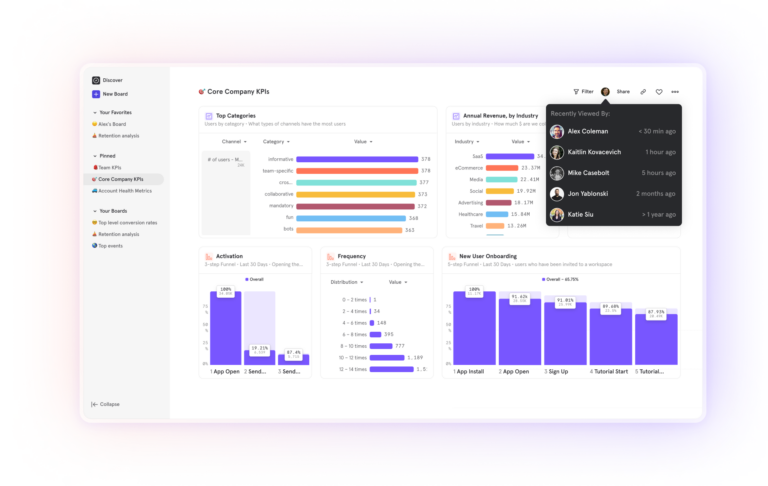
The self-serve revolution: Why data access is the next growth lever

Picture it: You’re a product leader working for a fast-paced startup, and keeping ahead of the competition is paramount. You need to make smart decisions, and you need to make them fast.
But getting even the simplest insight back from your data team takes days. They’re swamped and they’re constantly in triage mode—and your requests just aren’t rising to the top.
Meanwhile, your competitors ship pivots overnight. No matter what you do, you’re falling behind.
If this sounds familiar, you’re not alone. Many companies experience data bottlenecks. Data is siloed or accessible only by a handful of analysts who are tasked with interpreting and unlocking it for the rest of the company. Even many so-called “data-driven” companies still gate analyses behind specialist queues, stalling decision-making and revenue momentum.
Self-serve analytics can break down siloes and democratize access to data. Even more importantly, widespread data access can increase team productivity, improve decision-making, and speed up growth.
What “self-serve” really means (and what it doesn’t)
Lots of platforms claim to offer self-serve analytics—the trouble is, they’re stretching the definition of what self-serve analytics really means. In most cases, these tools offer access to self-serve monitoring. Don’t let them fool you: Monitoring and analytics aren’t the same thing.
Self-serve monitoring vs. self-serve analytics
Data monitoring and data analysis are not the same thing. When an analyst builds a business intelligence (BI) dashboard so that execs can track a KPI across the company, those execs can then monitor the data. But if they spot a discrepancy and want to investigate, they still have to call on an analyst to dig into what they’re seeing and come back with answers.
With self-serve analytics, execs (or anyone looking at that dashboard) can click on a metric, dive in, and look for answers themselves. Those answers lead to more questions, which lead to more answers, etc. Self-serve analytics is only possible with platforms that support independent data exploration, like Mixpanel.

If monitoring is a snapshot, analysis is a cycle:
→ Insights → Hypothesis → Analysis → Insights → Hypothesis → Analysis → Insights →
Data monitoring is important too, and you need both to be successful. But they serve different purposes, and it’s important to understand the difference.
The event-based data model behind true self-serve
Self-serve analytics is possible thanks to event-based data tracking. Event-based data models allow you to easily extend the event model with context or dimensional data to enrich the dataset, without needing to rerun a query each time. To do this, you need an event schema on your data, which you to map in any data warehouse model.
Why data access is the next growth lever
Fast, democratic, and straightforward data access is one of the keys to successful growth. Access to data means faster experimentation and results, which can cut iteration cycles from weeks down to days or even hours—as was the case for Yelp.
Faster data access and collaboration save a lot of time and resources. Our customers have reported an average of 35% time savings with self-serve analytics.
Democratized insights also correlate with outsized customer acquisition and loyalty, per McKinsey: “Intensive users of customer analytics are 23 times more likely to clearly outperform their competitors in terms of new customer acquisition than non-intensive users, and nine times more likely to surpass them in customer loyalty.”
Finally, investing in data accessibility and literacy can have a positive impact on your company culture and the talent you attract: A datacamp report found that “70% of leaders engaged in data upskilling have experienced more than 70% improvement in quality and speed of decision-making, innovation, customer experience, and employee retention.”
Playbooks: How leading teams move the lever
Let’s look at a few concrete examples of the value self-serve analytics unlock for different teams.
Product: Fast, insightful reports
The Ancestry product team needed to understand what was attracting the company’s best customers so that they could find and nurture more customers like them. To do that, PMs needed to conduct their own analyses, without an analyst’s help.
Growth and marketing: Improved user experience
Betterment wanted to meet its customers where they are. When the company began using Mixpanel self-serve analytics and Hightouch for a more complete picture of their user data, the product and go-to-market teams noticed that customers were converting at much higher rates on Betterment’s website than its mobile app. They used this knowledge to come up with solutions that fit different user segments and improve Betterment’s user experience across web and mobile.
Accounts teams and CS: Better customer conversations
Here at Mixpanel, our account teams use Mixpanel to pull insights about account health, usage, feature adoption, and power users to have better customer conversations. For example, our accounts team might see that a specific feature isn’t being used. They can bring that up in their conversation: Does their team need more training? Does the customer know about this feature? How can they help them get more value? Self-serve analytics can give account managers and customer success representatives a more complete picture of their accounts.
Building the self-serve stack
Choose the right self-serve analytics tool
Choosing the right analytics platform means understanding your company’s use case, existing tech stack and organizational norms and requirements. Each company is different—fintech companies might have additional security constraints, for example, and companies operating in the EU need to be GDPR compliant.
Read our step-by-step guide to help you choose the right analytics data architecture tech.
Sync and govern
Connect data from your warehouse to your self-serve analytics platform to eliminate data errors and break down siloes. In Mixpanel, you can choose between different sync modes—Mirror will keep Mixpanel perfectly in sync with the data in the warehouse. Keep your data secure with role-based access and permissions.

Enable and educate
Help your teams understand how to get the most value out of Mixpanel or your self-serve analytics platform—run workshops, share resources, and empower data champions to coach and encourage their peers.
Measuring the impact of self-serve analytics access
Self-serve analytics are valuable, and it’s important to quantify their ROI. Here are a few examples of KPIs that you can measure to evaluate your self-serve analytics.
Median time-to-insight
- OneLaunch, Yelp, Bilyoner, and EasyPark cut time to insight with Mixpanel.
- This metric shows eliminated ticket lag.
Analyst hours re-allocated to strategic work
- Taxifx re-allocated analyst hours with Mixpanel.
- This metric quantifies productivity gain.
Incremental revenue/retention lift
- PatientPing, Kast, and codeSpark saw increases in paid subscribers or increased retention thanks to Mixpanel.
- This metric ties data to dollars.
Quick-start checklist for self-serve analytics with Mixpanel
Here are a few simple steps to help you get started with Mixpanel. To learn more, check out our documentation.
- Track the critical events and metrics that map to your North Star metric.
- Use Warehouse Connectors and turn on Mirror mode to make historical context explorable.
- Invite stakeholders and introduce them to our templates to help them get started.
The competitive gap is widening
In a world where speed and insight drive product-led growth, the real edge isn’t just having data—it’s letting anyone use it. Self-serve access turns data from a cost center into a flywheel; the sooner teams can help themselves, the faster your company compounds.
Ready to unlock analytics for your whole team? Try Mixpanel for free.


